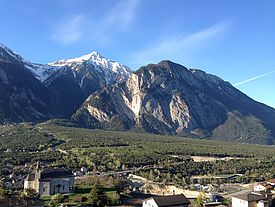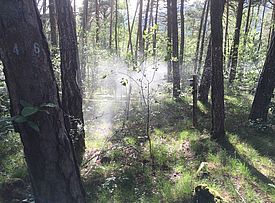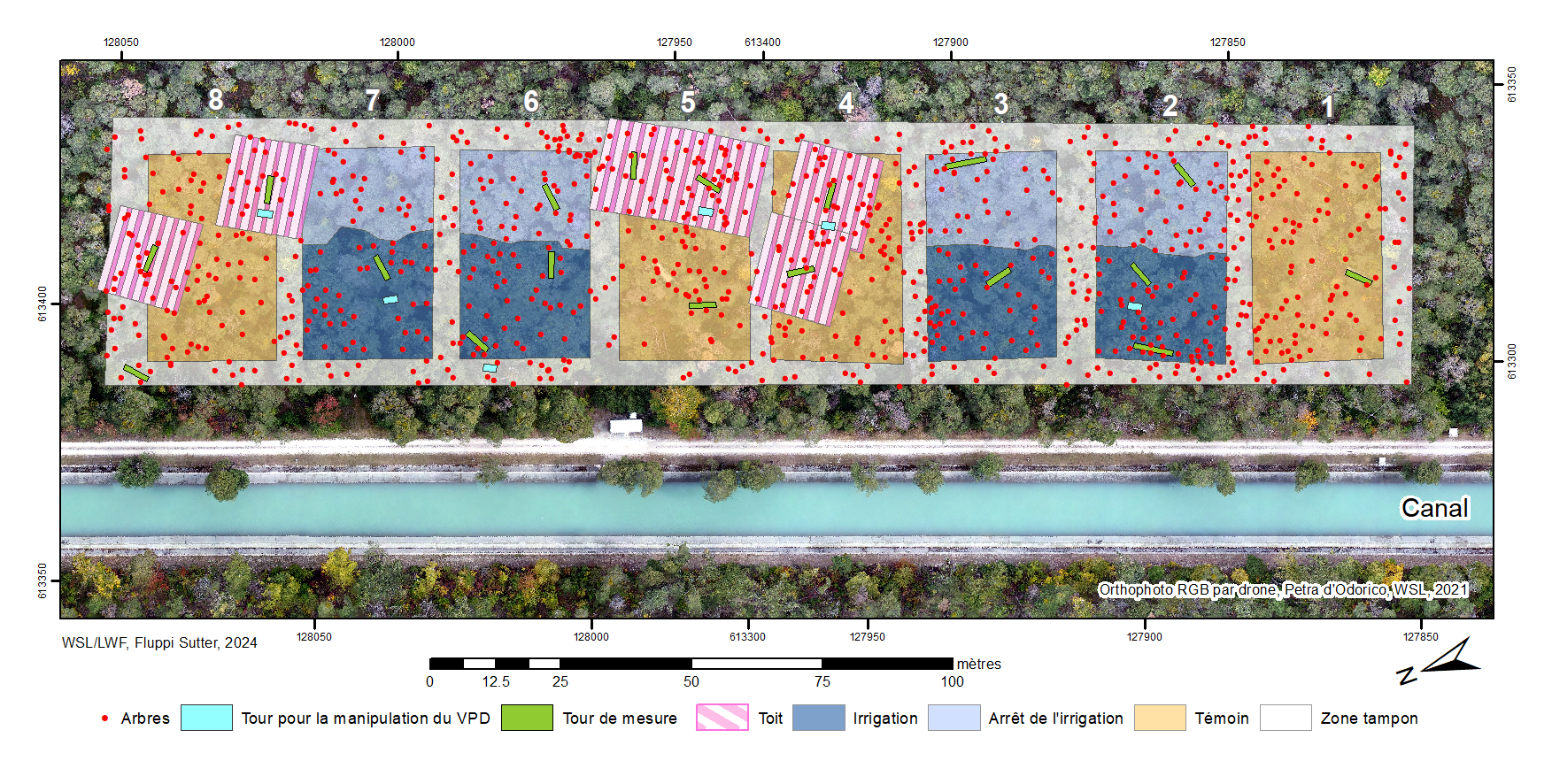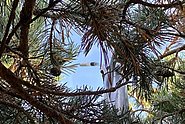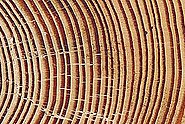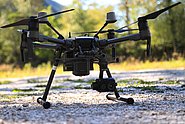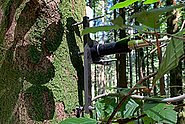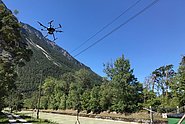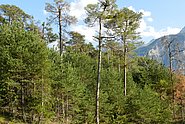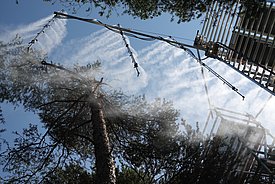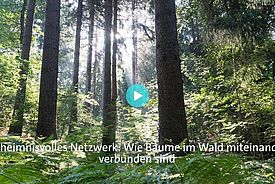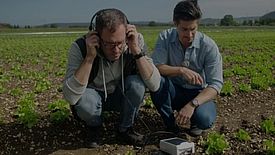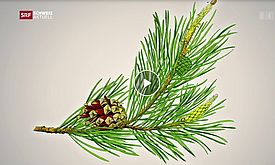
La plate-forme de recherche du Bois de Finges ¶
Au début de ce siècle, dans la vallée du Rhône entre Brigue et Sion (canton du Valais), l'une des vallées alpines intérieures les plus sèches des Alpes européennes, de nombreux pins sylvestres présentaient des symptômes frappants de sécheresse. Beaucoup d'arbres plus âgés étaient déjà morts. Pour comprendre les causes de ce dépérissement, le WSL a installé au cours de l'été 2003 une expérience d'irrigation contrôlée à long terme dans le Parc naturel Pfyn-Finges. L'objectif de cette expérience est de comparer les réactions de plusieurs centaines de pins sylvestres sur des parcelles forestières irriguées avec celles d'arbres qui continuent à ne recevoir que des quantités naturelles de pluie.
Depuis 2024, nous appliquons une approche supplémentaire, unique au monde, pour démêler les processus affectés par les sécheresses de l'atmosphère et du sol. Pour plus de détails, voir l'expérience VPDrought.
Index ¶
- Résultats actuels
- Sponsors
- Financement
- Coopérations
- Direction du projet
- Suppléants
- Participantes et participants
- Publications du WSL
- Publications
- Projets
- Multimedia
- Dans les médias
- Métadonnées et cartes
- Ateliers
- Conditions d'utilisation - Concept de sécurité - Politique en matière de publication et de données
Pour mieux comprendre les effets à moyen et long termes des périodes de sécheresse sur les forêts, il faut examiner les résultats d’essais menés dans des régions arides à l’aide de séries de mesures locales de longue durée.
Le Bois de Finges (canton du Valais; 46° 18’ N, 7° 36’ E, 615 m d’altitude) offre les meilleures conditions pour réaliser ces essais. C’est donc là, dans la plus grande pinède d'un seul tenant de Suisse, qu’une équipe de chercheurs du WSL a lancé une expérience sur 30 ans. La température annuelle moyenne y est de 10,6°C (moyenne entre 1995 et 2014) et la somme des précipitations annuelles s’élève à 575 mm (moyenne entre 1995 et 2014).
Sur ce site expérimental de 1,2 hectare, les pins ont 130 ans et mesurent 12 m de haut. Le site comprend environ 800 arbres répartis sur huit parcelles de 1000 m2 chacune (fig. 4). Quatre d’entre elles sont arrosées par aspersion entre avril et octobre et recueillent en plus chaque année 600 mm de précipitations. Les arbres des quatre autres parcelles croissent dans des conditions naturelles, à savoir relativement sèches.
Résultats actuels ¶
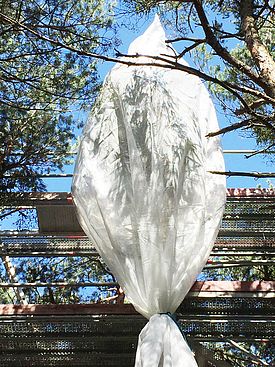
Presque immédiatement après le début des recherches en 2003, la production de fructifications de mycorhizes a nettement augmenté sur les parcelles irriguées. Après une année de décalage, les pins y produisent depuis 2004 des cernes plus larges et des aiguilles plus longues qu’auparavant. La longueur des pousses et la densité du peuplement ont également augmenté par la suite.
L’irrigation a en outre accéléré la croissance des racines et, à partir de l’été 2006, accru la biomasse, en particulier celle des racines fines (Brunner et al. 2009). La période de croissance des arbres irrigués s’est allongée de deux à cinq semaines (Eilmann et al. 2010).
Sur l'ensemble de la période expérimentale de 2003 à 2019, l'expérience d'irrigation nous a permis de suivre les trajectoires de récupération des arbres et de l'ensemble de l'écosystème non soumis à des conditions sèches naturelles. Les données sur 16 ans ont montré que l'irrigation a amélioré la disponibilité en eau du sol, et que les pins sylvestres de 120 ans ont retrouvé leur vigueur en augmentant la longueur des pousses, la longueur des aiguilles et la surface foliaire, et en diminuant la défoliation.
Nous avons détecté des réactions rapides et plus fortes des traits fonctionnels des arbres au-dessus du sol par rapport à ceux de la partie souterraine des arbres. L'altération des traits fonctionnels au-dessus du sol pendant les premières années d'irrigation a augmenté la demande en eau. Les arbres se sont adaptés en augmentant leur biomasse racinaire au cours des dernières années d'irrigation, ce qui a entraîné une augmentation du taux de survie des pins sylvestres dans les parcelles irriguées. Cependant, après avoir atteint un pic en 2006, l'ampleur de l'impact de l'irrigation sur un certain nombre de variables liées aux arbres a diminué au cours des années suivantes. Cette tendance à la baisse après avoir atteint le pic peut indiquer que l'approvisionnement constant en eau au fil des ans n'a pas permis de répondre à la demande en eau progressivement croissante liée à l'augmentation des activités de végétation.
Les résultats indiquent que l'augmentation de la disponibilité en eau à long terme a modifié les propriétés des arbres et de l'écosystème de telle sorte qu'un nouvel équilibre entre la disponibilité en eau du sol et la demande en eau est atteint, ce qui a modifié les conditions limites de l'écosystème. L'irrigation a également stimulé le taux de décomposition foliaire au niveau de l'écosystème, la biomasse des fructifications de champignons, et le taux de régénération chez les feuillus. L'irrigation n'a toutefois pas favorisé la régénération des pins sylvestres, réputés vulnérables aux sécheresses extrêmes (Bose et al. 2022).
Pour le travail de terrain, la carte peut être téléchargée et imprimée au format A3 ou A0.
À la fin du XXe siècle et au début du XXIe siècle, l’augmentation des températures en Suisse s’élevait à plus du double de la moyenne mondiale. Les modèles climatiques laissent envisager une hausse continue pour le XXIe siècle. Compte tenu de la hausse de l’évaporation liée à la chaleur et des vagues de chaleur toujours plus fréquentes, il faut partir du principe que l’alimentation en eau des arbres continuera à empirer et il faut s’attendre à de fortes précipitations pendant les mois d’été. Ces dernières accentueront le ruissellement des eaux en surface, qui ne s’infiltreront pas. Les plantes souffriront donc de plus en plus du stress hydrique.
Par conséquent, la vitalité et la croissance des pins diminueront. La sécheresse prolongée devrait entraîner le dépérissement croissant des arbres et le déplacement des zones de végétation. Ceci s’applique particulièrement aux écosystèmes forestiers dans les vallées sèches interalpines comme le Valais (Rigling et al. 2013).
Liens sur le sujet: Recherches à long terme sur les écosystèmes forestiers LWF, l'inventaire Sanasilva.
Sponsors ¶
Nous apprécions le soutien de longue date d’HYDRO Exploitation SA à Sion et des services forestiers à Loèche.
Financement ¶
Coopérations ¶
Direction du projet ¶
Suppléants ¶
Participantes et participants ¶
Publications du WSL ¶
Publications ¶
Pour citer correctement les études et données en relation avec le Bois de Finges dans votre publication, nous vous remercions de prendre en compte la citation suivante dans les remerciements (texte anglais voir ci-dessous):
«Cette étude se base sur les données de la plateforme de recherche expérimentelle à long terme du Bois de Finges, qui fait partie des infrastructures der recherche de Swiss Forest Lab et de eLTER. Nous sommes particulièrement reconnaissants à X qui nous a communiqué les données Z et à l'équipe centrale de Pfynwald pour leur soutien.»
"Evaluations are based on data from the long-term experimental research platform Pfynwald, which is part of the Swiss Forest Lab and the eLTER research infrastructures. We are in particular grateful to X who provided the Z data and the Pfynwald core team for their support."
Cuartero J., Brunner I., Schaub M., Gwiazdowicz D.J., Skubała P., Qin J., … Frey B. (2025) Comparing soil microarthropod communities derived directly from soil DNA metabarcoding with those from morphological assessment in a drought-prone and irrigated pine forest. Appl. Soil Ecol. 209, 106042 (14 pp.). https://doi.org/10.1016/j.apsoil.2025.106042Institutional Repository DORA
Hunziker S., Hug C., Schaub M., Waldner P., Gessler A. (2025) Gut Ding will Weile haben: Erkenntnisse zur Waldgesundheit aus Langzeitbeobachtungen. Schweiz. Z. Forstwes. 176(2), 72-76. https://doi.org/10.3188/szf.2025.0072 Institutional Repository DORA
Chin A.R.O., Gessler A., Laín O., Østerlund I., Schaub M., Théroux-Rancourt G., … Lambers J.H.R. (2025) The memory of past water abundance shapes trees 7 years later. Am. J. Bot. 112(1), e16452 (10 pp.). https://doi.org/10.1002/ajb2.16452Institutional Repository DORA
Chin A., Hille Ris Lambers J., Schaub M. (2025) Trees 'remember' wetter times − never having known abundant rain could buffer today’s young forests against climate change. The Conversation. Institutional Repository DORA
Shakas A., Hediger R., Gessler A., Singha K., de Pasquale G., D'Odorico P., … Meusburger K. (2025) Does optimality partitioning theory fail for belowground traits? Insights from geophysical imaging of a drought‐release experiment in a Scots Pine forest. New Phytol. 245(2), 546-558. https://doi.org/10.1111/nph.20245 Institutional Repository DORA
Cuartero J., Frey B., Eder R., Brunner I. (2024) More than a decade of irrigation alters soil nematode communities in a drought-prone Scots pine forest. Appl. Soil Ecol. 203, 105621 (10 pp.). https://doi.org/10.1016/j.apsoil.2024.105621Institutional Repository DORA
Gauthey A., Bachofen C., Chin A., Cochard H., Gisler J., Mas E., … Grossiord C. (2024) Twenty years of irrigation acclimation is driven by denser canopies and not by plasticity in twig- and needle-level hydraulics in a Pinus sylvestris forest. J. Exp. Bot. 75(10), 3141-3152. https://doi.org/10.1093/jxb/erae066 Institutional Repository DORA
Hunziker S., Nazarova T., Kather M., Hartmann M., Brunner I., Schaub M., … Gessler A. (2024) The metabolic fingerprint of Scots pine – root and needle metabolites show different patterns in dying trees. Tree Physiol. 44(4), tpae036 (10 pp.). https://doi.org/10.1093/treephys/tpae036Institutional Repository DORA
Vitali V., Schuler P., Holloway‐Phillips M., D'Odorico P., Guidi C., Klesse S., … Saurer M. (2024) Finding balance: tree‐ring isotopes differentiate between acclimation and stress‐induced imbalance in a long‐term irrigation experiment. Glob. Chang. Biol. 30(3), e17237 (20 pp.). https://doi.org/10.1111/gcb.17237Institutional Repository DORA
Gao D., Luster J., Zürcher A., Arend M., Bai E., Gessler A., … Hagedorn F. (2024) Drought resistance and resilience of rhizosphere communities in forest soils from the cellular to ecosystem scale – insights from 13C pulse labeling. New Phytol. 242(3), 960-974. https://doi.org/10.1111/nph.19612 Institutional Repository DORA
Hartmann M., Herzog C., Brunner I., Stierli B., Meyer F., Buchmann N., Frey B. (2023) Long-term mitigation of drought changes the functional potential and life-strategies of the forest soil microbiome involved in organic matter decomposition. Front. Microbiol. 14, 1267270 (16 pp.). https://doi.org/10.3389/fmicb.2023.1267270Institutional Repository DORA
Gauthey A., Bachofen C., Deluigi J., Didion-Gency M., D'Odorico P., Gisler J., … Grossiord C. (2023) Absence of canopy temperature variation despite stomatal adjustment in Pinus sylvestris under multidecadal soil moisture manipulation. New Phytol. 240(1), 127-137. https://doi.org/10.1111/nph.19136 Institutional Repository DORA
Guidi C., Lehmann M.M., Meusburger K., Saurer M., Vitali V., Peter M., … Hagedorn F. (2023) Tracing sources and turnover of soil organic matter in a long-term irrigated dry forest using a novel hydrogen isotope approach. Soil Biol. Biochem. 184, 109113 (10 pp.). https://doi.org/10.1016/j.soilbio.2023.109113Institutional Repository DORA
Zhang Y.L., Yang Y., Saurer M., Schaub M., Gessler A., Lehmann M.M., … Li M.H. (2023) Sugar infusion into trees: a novel method to study tree carbon relations and its regulations. Front. Plant Sci. 14, 1142595 (11 pp.). https://doi.org/10.3389/fpls.2023.1142595Institutional Repository DORA
Zweifel R., Pappas C., Peters R.L., Babst F., Balanzategui D., Basler D., … Sterck F. (2023) Networking the forest infrastructure towards near real-time monitoring - a white paper. Sci. Total Environ. 872, 162167 (11 pp.). https://doi.org/10.1016/j.scitotenv.2023.162167Institutional Repository DORA
Saurer M., Sahlstedt E., Rinne-Garmston K.T., Lehmann M.M., Oettli M., Gessler A., Treydte K. (2023) Progress in high-resolution isotope-ratio analysis of tree rings using laser ablation. Tree Physiol. 43(5), 694-705. https://doi.org/10.1093/treephys/tpac141 Institutional Repository DORA
Hunziker S., Begert M., Scherrer S.C., Rigling A., Gessler A. (2022) Below average midsummer to early autumn precipitation evolved into the main driver of sudden scots pine vitality decline in the Swiss Rhône Valley. Front. For. Glob. Change. 5, 874100 (20 pp.). https://doi.org/10.3389/ffgc.2022.874100Institutional Repository DORA
Maeder M., Guo X., Neff F., Schneider Mathis D., Gossner M.M. (2022) Temporal and spatial dynamics in soil acoustics and their relation to soil animal diversity. PLoS One. 17(3), e0263618 (22 pp.). https://doi.org/10.1371/journal.pone.0263618Institutional Repository DORA
Guidi C., Frey B., Brunner I., Meusburger K., Vogel M.E., Chen X., … Hagedorn F. (2022) Soil fauna drives vertical redistribution of soil organic carbon in a long‐term irrigated dry pine forest. Glob. Chang. Biol. 28(9), 3145-3160. https://doi.org/10.1111/gcb.16122 Institutional Repository DORA
Bose A.K., Rigling A., Gessler A., Hagedorn F., Brunner I., Feichtinger L., … Schaub M. (2022) Lessons learned from a long‐term irrigation experiment in a dry Scots pine forest: impacts on traits and functioning. Ecol. Monogr. 92(2), e1507 (18 pp.). https://doi.org/10.1002/ecm.1507Institutional Repository DORA
Rissanen K., Aalto J., Gessler A., Hölttä T., Rigling A., Schaub M., Bäck J. (2022) Drought effects on volatile organic compound emissions from Scots pine stems. Plant Cell Environ. 45(1), 23-40. https://doi.org/10.1111/pce.14219 Institutional Repository DORA
D'Odorico P., Schönbeck L., Vitali V., Meusburger K., Schaub M., Ginzler C., … Ensminger I. (2021) Drone‐based physiological index reveals long‐term acclimation and drought stress responses in trees. Plant Cell Environ. 44(11), 3552-3570. https://doi.org/10.1111/pce.14177 Institutional Repository DORA
Eugster W., Baumgartner L.P., Bachmann O., Baltensperger U., Dèzes P., Dubois N., … RoTaGeo team (2021) Geosciences roadmap for research infrastructures 2025–2028 by the Swiss Geosciences Community. (Swiss Academies reports, Report No.: 16/4). Swiss Academy of Sciences (SCNAT). 55 p. https://doi.org/10.5281/zenodo.4588881Institutional Repository DORA
Gao D., Joseph J., Werner R.A., Brunner I., Zürcher A., Hug C., … Hagedorn F. (2021) Drought alters the carbon footprint of trees in soils—tracking the spatio-temporal fate of 13C-labelled assimilates in the soil of an old-growth pine forest. Glob. Chang. Biol. 27, 2491-2506. https://doi.org/10.1111/gcb.15557 Institutional Repository DORA
Rissanen K., Hölttä T., Bäck J., Rigling A., Wermelinger B., Gessler A. (2021) Drought effects on carbon allocation to resin defences and on resin dynamics in old-grown Scots pine. Environ. Exp. Bot. 185, 104410 (13 pp.). https://doi.org/10.1016/j.envexpbot.2021.104410Institutional Repository DORA
Mathys A.S., Brang P., Stillhard J., Bugmann H., Hobi M.L. (2021) Long-term tree species population dynamics in Swiss forest reserves influenced by forest structure and climate. For. Ecol. Manag. 481, 118666 (10 pp.). https://doi.org/10.1016/j.foreco.2020.118666Institutional Repository DORA
Wang A., Siegwolf R.T.W., Joseph J., Thomas F.M., Werner W., Gessler A., … Lehmann M.M. (2021) Effects of soil moisture, needle age and leaf morphology on carbon and oxygen uptake, incorporation and allocation: a dual labeling approach with 13CO2 and H218O in foliage of a coniferous forest. Tree Physiol. 41(1), 50-62. https://doi.org/10.1093/treephys/tpaa114 Institutional Repository DORA
Joseph J., Gao D., Backes B., Bloch C., Brunner I., Gleixner G., … Gessler A. (2020) Rhizosphere activity in an old-growth forest reacts rapidly to changes in soil moisture and shapes whole-tree carbon allocation. Proc. Natl. Acad. Sci. U. S. A. 117(40), 24885-24892. https://doi.org/10.1073/pnas.2014084117 Institutional Repository DORA
Timofeeva G., Treydte K., Bugmann H., Salmon Y., Rigling A., Schaub M., … Saurer M. (2020) How does varying water supply affect oxygen isotope variations in needles and tree rings of Scots pine? Tree Physiol. 40(10), 1366-1380. https://doi.org/10.1093/treephys/tpaa082 Institutional Repository DORA
Schönbeck L.C. (2019) Drought effects on carbon and nutrient dynamics in Scots pine. Homeostasis, thresholds and tipping points. [Doctoral dissertation] University of Basel. 131 p. https://doi.org/10.5451/unibas-007175123 Institutional Repository DORA
Zweifel R., Etzold S., Sterck F., Gessler A., Anfodillo T., Mencuccini M., … Rigling A. (2020) Determinants of legacy effects in pine trees - implications from an irrigation-stop experiment. New Phytol. 227(4), 1081-1096. https://doi.org/10.1111/nph.16582 Institutional Repository DORA
Bose A.K., Moser B., Rigling A., Lehmann M.M., Milcu A., Peter M., … Gessler A. (2020) Memory of environmental conditions across generations affects the acclimation potential of scots pine. Plant Cell Environ. 43(5), 1288-1299. https://doi.org/10.1111/pce.13729 Institutional Repository DORA
Hagedorn F., Walthert L., Luster J. (2019) Föhrensterben im Walllis: Auswirkung von Trockenheit auf den Wasser- und Kohlenstoffkreislauf des Pfynwaldes. In DBG Mitteilungen: Vol. 119. Exkursionsführer Bern 2019. Erd-reich und Boden-Landschaften. Kiel; Göttingen: DGB. 125-136. Institutional Repository DORA
Brunner I., Herzog C., Galiano L., Gessler A. (2019) Plasticity of fine-root traits under long-term irrigation of a water-limited scots pine forest. Front. Plant Sci. 10, 701 (10 pp.). https://doi.org/10.3389/fpls.2019.00701Institutional Repository DORA
Herzog C., Hartmann M., Frey B., Stierli B., Rumpel C., Buchmann N., Brunner I. (2019) Microbial succession on decomposing root litter in a drought-prone Scots pine forest. ISME J. 13(9), 2346-2362. https://doi.org/10.1038/s41396-019-0436-6 Institutional Repository DORA
Rigling A., Etzold S., Bebi P., Brang P., Ferretti M., Forrester D., … Wohlgemuth T. (2019) Wie viel Trockenheit ertragen unsere Wälder? Lehren aus extremen Trockenjahren. In M. Bründl & J. Schweizer (Eds.), WSL Berichte: Vol. 78. Lernen aus Extremereignissen. Birmensdorf: Eidg. Forschungsanstalt für Wald, Schnee und Landschaft. 39-51. https://doi.org/10.55419/wsl:19983 Institutional Repository DORA
Wohlgemuth T., Doublet V., Nussbaumer C., Feichtinger L., Rigling A. (2018) Baumartenwechsel in den Walliser Waldföhrenwäldern verstärkt nach grossen Störungen. Schweiz. Z. Forstwes. 169(5), 260-268. https://doi.org/10.3188/szf.2018.0260 Institutional Repository DORA
He P., Fontana S., Sui X., Gessler A., Schaub M., Rigling A., … Li M.H. (2018) Scale dependent responses of pine reproductive traits to experimental and natural precipitation gradients. Environ. Exp. Bot. 156, 62-73. https://doi.org/10.1016/j.envexpbot.2018.08.028 Institutional Repository DORA
Solly E.F., Brunner I., Helmisaari H.S., Herzog C., Leppälammi-Kujansuu J., Schöning I., … Hagedorn F. (2018) Unravelling the age of fine roots of temperate and boreal forests. Nat. Commun. 9(1), 3006 (8 pp.). https://doi.org/10.1038/s41467-018-05460-6Institutional Repository DORA
Grossiord C., Sevanto S., Limousin J.M., Meir P., Mencuccini M., Pangle R.E., … McDowell N.G. (2018) Manipulative experiments demonstrate how long-term soil moisture changes alter controls of plant water use. Environ. Exp. Bot. 152, 19-27. https://doi.org/10.1016/j.envexpbot.2017.12.010 Institutional Repository DORA
Timofeeva G., Treydte K., Bugmann H., Rigling A., Schaub M., Siegwolf R., Saurer M. (2017) Long-term effects of drought on tree-ring growth and carbon isotope variability in Scots pine in a dry environment. Tree Physiol. 37(8), 1028-1041. https://doi.org/10.1093/treephys/tpx041 Institutional Repository DORA
Boesch R. (2017) Thermal remote sensing with UAV-based workflows. In C. Stachniss, W. Förstner, & J. Schneider (Eds.), The international archives of the photogrammetry, remote sensing and spatial information sciences: Vol. XLII-2. The international archives of the photogrammetry, remote sensing and spatial information sciences. International Society for Photogrammetry and Remote Sensing. 41-46. https://doi.org/10.5194/isprs-archives-XLII-2-W6-41-2017 Institutional Repository DORA
Dobbertin M., Giuggiola A. (2006) Baumwachstum und erhöhte Temperaturen. In T. Wohlgemuth (Ed.), Forum für Wissen: Vol. 2006. Wald und Klimawandel. Birmensdorf: Eidgenössische Forschungsanstalt für Wald, Schnee und Landschaft. 35-45. Institutional Repository DORA
von Arx G., Arzac A., Fonti P., Frank D., Zweifel R., Rigling A., … Olano J.M. (2017) Responses of sapwood ray parenchyma and non-structural carbohydrates of Pinus sylvestris to drought and long-term irrigation. Funct. Ecol. 31(7), 1371-1382. https://doi.org/10.1111/1365-2435.12860 Institutional Repository DORA
Hartmann M., Brunner I., Hagedorn F., Bardgett R.D., Stierli B., Herzog C., … Frey B. (2017) A decade of irrigation transforms the soil microbiome of a semi-arid pine forest. Mol. Ecol. 26(4), 1190-1206. https://doi.org/10.1111/mec.13995 Institutional Repository DORA
Mencuccini M., Salmon Y., Mitchell P., Hölttä T., Choat B., Meir P., … Pfautsch S. (2017) An empirical method that separates irreversible stem radial growth from bark water content changes in trees: theory and case studies. Plant Cell Environ. 40(2), 290-303. https://doi.org/10.1111/pce.12863 Institutional Repository DORA
Gessler A., Schaub M., McDowell N.G. (2017) The role of nutrients in drought-induced tree mortality and recovery. New Phytol. 214(2), 513-520. https://doi.org/10.1111/nph.14340 Institutional Repository DORA
Brunner I. (2006) Licht ins Dunkel der Wurzelwelt. In Tagungsband der 24. Osnabrücker Baumpflegetage 2006. Osnabrück: Fachbereich Grün und Umwelt. 35-40. Institutional Repository DORA
Martinéz-Vilalta J., Cochard H., Mencuccini M., Sterck F., Herrero A., Korhonen J.F.J., … Zweifel R. (2009) Hydraulic adjustment of Scots pine across Europe. New Phytol. 184(2), 353-364. https://doi.org/10.1111/j.1469-8137.2009.02954.x Institutional Repository DORA
Brunner I., Graf Pannatier E., Frey B., Rigling A., Landolt W., Zimmermann S., Dobbertin M. (2009) Morphological and physiological responses of Scots pine fine roots to water supply in a dry climatic region in Switzerland. Tree Physiol. 29(4), 541-550. https://doi.org/10.1093/treephys/tpn046 Institutional Repository DORA
Dobbertin M., Eilmann B., Bleuler P., Giuggiola A., Graf Pannatier E., Landolt W., … Rigling A. (2010) Effect of irrigation on needle morphology, shoot and stem growth in a drought-exposed Pinus sylvestris forest. Tree Physiol. 30(3), 346-360. https://doi.org/10.1093/treephys/tpp123 Institutional Repository DORA
Yan C.F., Gessler A., Rigling A., Dobbertin M., Han X.G., Li M.H. (2016) Effects of mistletoe removal on growth, N and C reserves, and carbon and oxygen isotope composition in Scots pine hosts. Tree Physiol. 36(5), 562-575. https://doi.org/10.1093/treephys/tpw024 Institutional Repository DORA
Eilmann B., Dobbertin M., Rigling A. (2013) Growth response of Scots pine with different crown transparency status to drought release. Ann. For. Sci. 70(7), 685-693. https://doi.org/10.1007/s13595-013-0310-z Institutional Repository DORA
Sterck F.J., Martínez-Vilalta J., Mencuccini M., Cochard H., Gerrits P., Zweifel R., … Sass-Klaassen U. (2012) Understanding trait interactions and their impacts on growth in Scots pine branches across Europe. Funct. Ecol. 26(2), 541-549. https://doi.org/10.1111/j.1365-2435.2012.01963.x Institutional Repository DORA
Eilmann B., Zweifel R., Buchmann N., Graf Pannatier E., Rigling A. (2011) Drought alters timing, quantity, and quality of wood formation in Scots pine. J. Exp. Bot. 62(8), 2763-2771. https://doi.org/10.1093/jxb/erq443 Institutional Repository DORA
Eilmann B., Buchmann N., Siegwolf R., Saurer M., Cherubini P., Rigling A. (2010) Fast response of Scots pine to improved water availability reflected in tree-ring width and δ13C. Plant Cell Environ. 33(8), 1351-1360. https://doi.org/10.1111/j.1365-3040.2010.02153.x Institutional Repository DORA
von Arx G., Arzac A., Olano J.M., Fonti P. (2015) Assessing conifer ray parenchyma for ecological studies: pitfalls and guidelines. Front. Plant Sci. 6(11), 1016 (10 pp.). https://doi.org/10.3389/fpls.2015.01016Institutional Repository DORA
Herzog C., Steffen J., Graf Pannatier E., Hajdas I., Brunner I. (2014) Nine years of irrigation cause vegetation and fine root shifts in a water-limited pine forest. PLoS One. 9(5), e96321 (11 pp.). https://doi.org/10.1371/journal.pone.0096321Institutional Repository DORA
Breitenmoser P., Brönnimann S., Frank D. (2014) Forward modelling of tree-ring width and comparison with a global network of tree-ring chronologies. Clim. Past. 10(2), 437-449. https://doi.org/10.5194/cp-10-437-2014 Institutional Repository DORA
Projets ¶
Multimedia ¶
Pour en savoir plus: https://www.wsl.ch/drone-finges
Dans les médias ¶
Dans le bois de Finges, des chercheurs étudient les effets de la sècheresse sur les arbres au moyen de brumisateurs géants ¶
Reportage du 19h30 (RTS La Première) le 28 août 2024
Un brouillard artificiel pour tester l'impact du changement climatique sur les forêts ¶
Dossier de la RTS La Première du 29 août 2024, reportage de La Matinale (2') et sujet de CQFD (14'49")
Une nouvelle étude menée dans la forêt de Finges le montre : la sécheresse inhibe le stockage de carbone par les vers de terre. ¶
![[Translate to Französisch:] Trockenheit hemmt Kohlenstoffspeicherung durch Regenwürmer.](/fileadmin/_processed_/f/b/csm_kanal9pfynwald_CO2_510428f9f5.jpg)
Les vers de terre en plein sommeil : en raison du changement climatique, les périodes de sécheresse sont de plus en plus longues, ce qui met à mal les organismes vivant dans le sol. Une étude de longue haleine menée dans la forêt de Finges montre à quel point. (Canal 9, 9.06.2022).
Chercheurs : les sols forestiers secs peuvent stocker moins de CO2 à long terme ¶
![[Translate to Französisch:] Trockene Waldböden können langfristig weniger CO2 speichern](/fileadmin/_processed_/7/7/csm_deutschlandfunk_CO2_d7b2da97be.jpg)
Les sols forestiers secs ont un effet négatif sur le changement climatique, car les vers de terre en particulier ne pourraient plus bien contribuer à la fixation du carbone dans les sols, explique l'expert en cycle des matières Frank Hagedorn au Dlf. En cas de sécheresse, les vers de terre décomposent moins la litière de feuilles. A long terme, le sol stockerait ainsi moins de carbone et donc de CO2 ayant un impact sur le climat.
Krauter, Ralf, Deutschlandfunk | 01. 06. 2022, 16:47
Réseau mystérieux : comment les arbres sont connectés dans la forêt ¶
Éco-acoustique : la piste sonore du changement climatique. SRF Einstein ¶
Quel est le son du sol ? Quel est le son de la forêt lors d'un été sec ? Les éco-acousticiens, comme le chercheur suisse en son Marcus Maeder, décrivent la nature de manière totalement nouvelle à l'aide d'enregistrements sonores. Le son devient l'indicateur d'un écosystème. "Einstein" montre les opportunités offertes par l'éco-acoustique.
Mort des pins en Valais - les chercheurs enveloppent les arbres dans du plastique. ¶
Les forêts de pins du Valais sont menacées. Dans certaines régions, jusqu'à 40 pour cent des arbres sont morts au cours des deux dernières années. Ceci parce qu'il a fait particulièrement chaud et sec. La protection que les forêts concernées offrent contre les chutes de pierres et les avalanches s'en trouve réduite.
Métadonnées et cartes ¶
Métadonnées et cartes
- Commencez-vous une nouvelle étude ou mettez-vous à jour une étude en cours? Veuillez télécharger le fichier Excel suivant avec les métadonnées Pfynwald, compléter vos informations actuelles en rouge et envoyer le fichier par e-mail à Marcus Schaub.
- Pfyn_Metadata_vrs49.xlsx
Carte
- Pfynwald 2024 (3,5 Mo)
Ateliers ¶
Ateliers
- 2024 atelier du Pfynwald, WSL, 7 Mars 2024
- 2022 Pfynwald Workshop, WSL, 14 Feb 2022
-
2020 Pfynwald Workshop, WSL, 17 Sept 2020
-
2015 LWF-Pfynwald Workshop
- 2014 Pfynwald Workshop
- 2013 Pfynwald Workshop
Conditions d'utilisation - Concept de sécurité - Politique en matière de publication et de données ¶
Toute collaboration sur la plate-forme de recherche du Pfynwald est la bienvenue! Pour votre sécurité et pour l'intégrité du site forestier, nous demandons aux collaborateurs de prendre connaissance des conditions d'utilisation et du concept de sécurité. Notre protocole d'accord s'applique en ce qui concerne la publication et l'utilisation de données.

